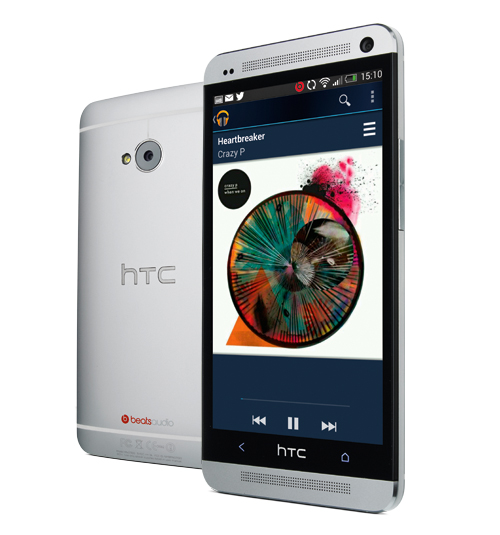What Hi-Fi? Verdict
A great return to form for HTC, with a product that sets the bar high for new smartphones in 2013
Pros
- +
Well-built
- +
Powerful
- +
Great sound
- +
Intuitive user interface
- +
Nice screen
Cons
- -
No memory slot
- -
Camera could be better
Why you can trust What Hi-Fi?
Its first handset, known here as the G1, was also the first to use Google’s Android operating system and for a few years after, the company consistently released excellent, well-designed phones that constantly outsmarted the competition.
More recently, though, HTC hasn’t quite managed to match the success of its first few years on the market. Its handsets have been good, but not mind-blowing, and the design philosophy that had once made it stand out from the crowd became rather samey and predictable.
Enter the HTC One. Previously the name of a family of HTC handsets, it is now reclaimed as the name of the company’s flagship smartphone.
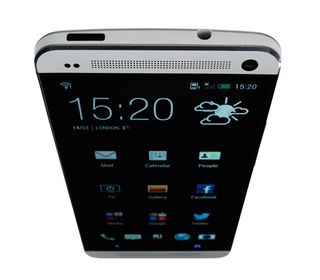
HTC One: build and design
Hold the HTC One in your hand and you immediately feel like you’re holding a premium product. With the HTC One price hovering around the £520 mark for a SIM-free phone, it's in fact positioned pretty closely to the likes of the iPhone 5, Galaxy S4 and Xperia Z.
Its slightly curved anodized aluminium unibody design sits in stark contrast to the polycarbonate body of the HTC One X, instead revisiting the design cues learned from the likes of the HTC Legend and the HTC Desire.
However, whereas previously there had to be panels of rubber to allow the antenna inside work, new technology has allowed HTC to do away with these to create its first full metal handset. The result is a resounding success – it looks nothing short of stunning.
MORE: Samsung Galaxy S4 – everything you need to know
The 4.7in display makes the HTC One rather large compared with the Apple iPhone 5, but puts it just a touch smaller than the 5in Sony Xperia Z and the recently launched Samsung Galaxy S4. There’s very little bezel around the screen to keep the overall size to a minimum (13.7 x 6.8 x 0.9cm), with aluminium topping-and-tailing the screen to tie the whole design together nicely.
It feels great in your hand, too: sturdy, even, with its curved edges making it more comfortable to hold than the angular Xperia Z. While it measures just over 9mm at its thickest point, when held alongside the thinner iPhone 5 you can feel very little difference between the two. At 143g, it’s heavier too, but doesn’t feel cumbersome – just solid.
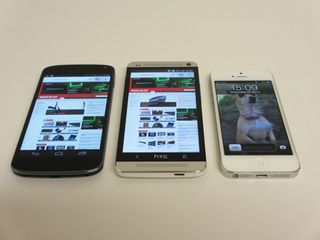
HTC One: display & video performance
The display has to be up there as one of the best we’ve ever seen on a smartphone. It’s Full HD at 1920 x 1080 and tops the smartphone charts with 468 pixels per inch. The result is a seriously sharp screen that shows great detail, and is an absolute joy to watch video on.
There’s a slight blue tinge to some dark scenes but colour reproduction is on the whole convincing and vivid without being overdone. Whites are brighter than those found on the Nexus 4 too, and contrast is good, with objects given precise edges – even in darker scenes.
Viewing angles are also great, trumping those on both the Sony Xperia Z and the Google Nexus 4, even in bright light.
HTC One: TV remote control
A rather clever added extra is the power/lock button on the top of the phone doubles as an infrared ‘eye’ for controlling your TV. A pre-loaded TV app accompanies this; it can pull in the programming details for your TV provider (Sky, Virgin, Freeview and Freesat in the UK) and offer a visual view of what’s on TV now and next, or provide a standard-look EPG.
Clicking on something that is on now will, once you’ve completed the brief setup between your TV and the phone, take you to that programme, while clicking something on next or later will pull up a synopsis, a list of upcoming episodes and where and when you can watch them.
You can then set reminders for a single show or, if applicable, the whole series, which will appear in your calendar and, if you choose, your BlinkFeed (see later for more on that).
We found this feature worked well, but it’s little more than a nice added extra. Sky and Virgin offer more accomplished apps for controlling their services.
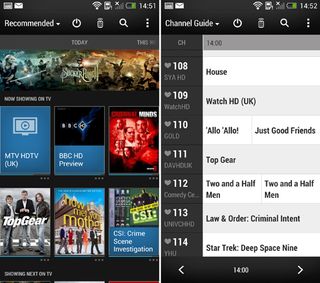
HTC One: performance, storage and connectivity
So what’s powering all this? Under the hood you’ll find a Qualcomm Snapdragon 1.7GHz quad-core processor, supported by 2GB of RAM. This combination makes for a seriously smooth and snappy experience, with no lag in sight even when we were dipping in and out of several apps at once. We tested the HTC One against both the iPhone 5 and Nexus 4 for loading up several different YouTube videos on the same wi-fi network, and it came first every time.
The 32GB of onboard storage can’t be expanded (an inherent downside to unibody designs), although it does come with 25GB of free Dropbox storage for two years to help ease the burden of your massive mobile library.
MORE: Google Nexus 4 review
When it comes to connectivity, you get pretty much a full house of options. The One is an LTE handset for connecting to 4G networks, has dual channel wi-fi, offers Bluetooth 4.0 with aptX support for improved sound quality and packs NFC too, for quick pairing with other NFC devices.
On the outside, it has a standard micro-USB port on the bottom for charging and hooking up to your computer and, on the top, a 3.5mm headphone jack.
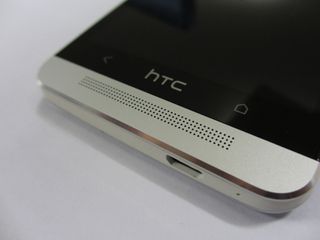
HTC One: user interface and BlinkFeed
The HTC One runs on Android 4.1.2 out of the box, and comes with the most recent iteration of HTC’s user interface, HTC Sense 5.0, sitting over the top of it. It’s had quite an overhaul compared with previous versions, which gives the HTC One an immediately different look to older HTC phones.
The whole interface has a much more minimalist, grown-up feel to it. The memorable flip clock and weather app that was so prominent on previous handsets is gone, replaced by a simpler, monochrome graphic that sits atop the BlinkFeed (more on that shortly) and the app tray.
In fact, even the app tray has been simplified – logos look cleaner and the grid size can be changed so it fits more or less apps per page.
The launcher bar at the bottom of the screen is completely customisable as before, but can now hold folders of apps for quicker access to more stuff. Also, unlike other Android phones such as the Nexus 4, these apps aren’t then repeated in the app tray, keeping everything looking nicely uncluttered.
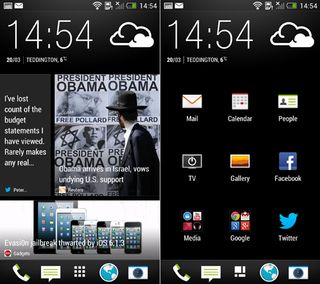
There’s been a small change to controls as well, in that there are only touch controls for back and home on the bottom of the HTC One (the recent apps control has been binned). Instead, double-tap the home button and a screen filled with recent and open apps will appear in place of the scrolling carousel found on other Android phones.
BlinkFeed is the new default homescreen for the HTC One, and is ultimately a customisable aggregator of information from your choice of feeds and services.
Depending on your settings, it will bring you updates, photos and videos from friends on Twitter and Facebook, news stories on specific subjects or from chosen sources, and even calendar reminders as well.
HANDS ON: Samsung Galaxy S4 review
They’re all presented in a visual tiled design, on a rather lovely vertical 3D carousel, with full details just a click away. You can also filter the stories shown by source, search them for a certain term and update your Facebook and Twitter statuses without needing to load a separate app.
If you don’t like BlinkFeed, a swipe to the left will take you back to an Android homescreen you recognise, and you can also set that as your default homescreen instead. There is no way of completely removing BlinkFeed, but we found it to be a nice addition – we just look forward to more UK news providers coming on board over time.
All in all, HTC Sense 5.0 is as intuitive as ever, making it easy to navigate for Android evangelists and newbies alike.
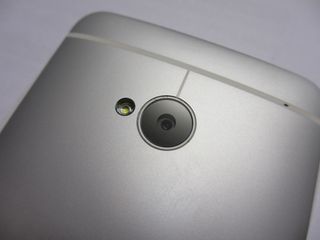
HTC One: audio performance
HTC has given the One’s audio performance serious thought. As has been the case with HTC handsets since the Sensation XE in 2011, Beats Audio is on board, bringing its warm, bassy tones to playback. This won’t be to everyone’s taste, especially as you’ll forego some clarity for that extra oomph, but it can easily be turned off in the settings.
However, there’s much more to talk about here. In particular, HTC has really put some effort into the audio experience when you’re not wearing headphones, finally waving goodbye to the tinny smartphone audio experience of old.
MORE: SoundMagic E10 headphones review
On the front of the phone, at the top and bottom of the display, are two speakers, placed behind rather retro looking grilles. They form a stereo pair when the phone is held in landscape mode, and placing them here certainly makes sense: it directs the sound straight at you, and ensures that no matter how you hold it, the speakers aren’t blocked.
We’ll ignore HTC’s decision to give this feature the rather ridiculous name of BoomSound and judge them on their merit instead. Compare the sound with the speakers on an iPhone 5 and the difference is easily noticeable.
Sound is much clearer and more powerful, reaching higher volumes with little distortion, and providing a considerably wider soundfield as well. It’s easily the best sound we’ve heard on a smartphone, and a nice attention to detail that is very much to HTC’s credit.
As for listening to a track through headphones, the HTC One shows similar clarity and punch as it does through the speakers, if not quite offering the togetherness and timing of the iPhone 5.
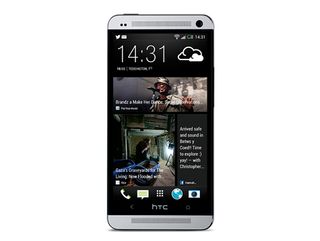
HTC One: call quality
Cool features aside, how does the HTC One actually perform as a phone? Having tried it in a number of different environments, we found voices to be clear, natural and easily audible, with no dropped calls in our time with it.
In particular, attention has been paid to calls made in noisy environments. Conventional built-in noise cancellation does a great job for helping the other person on the line to hear you, but it won’t help you to hear them.
HTC has attempted to rectify this with Sense Voice – a feature that incorporates dual microphones to detect loud ambient noise around you, raising the in-call volume automatically to suit.
While we can’t vouch for it in a loud environment like a club (our clubbing days are somewhat behind us), a call made from a pub wasn’t scuppered by the hubbub around us, and both caller and callee could be heard clearly.
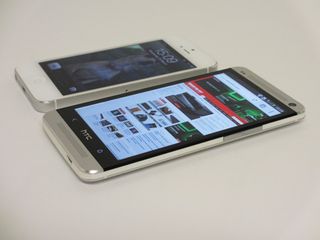
HTC One: camera
Another feature that HTC has paid a lot of attention to is its camera. Taking a step back from ‘pixel chasing’, it’s scaled its camera back to just 4MP, but is using larger pixels called ‘Ultrapixels’ instead. The ultimate aim to this is to increase the amount of light absorbed on the sensor (Ultrapixels can apparently absorb 300 per cent more light than a regular pixel), for more detailed and better quality low-light snaps.
The HTC One also has an f/2.0 lens (the iPhone 5’s is an f/2.4 model), further helping its cause in low-light conditions.
Take a look at some of our test shots below – the HTC One’s results are either to the right of or below a picture taken in the same conditions with the iPhone 5.
The results are a pretty successful. Colour reproduction in good light is on the whole realistic, although we have to say we still prefer the colour balance on the iPhone 5. In our test shots, colours were more vivid on the iPhone and there was more detail compared with the shots taken on the One, which could look a little washed out.

Put the HTC in a low light situation, though, and it’s a different story. The pictures it produces are brighter and clearer, with less noise, than those from the iPhone 5. Even when using the flash, the iPhone 5 has a tendency to bleach-out white areas, whereas the One gives a much more natural, even coverage that meant you wouldn’t immediately know the flash had been used.


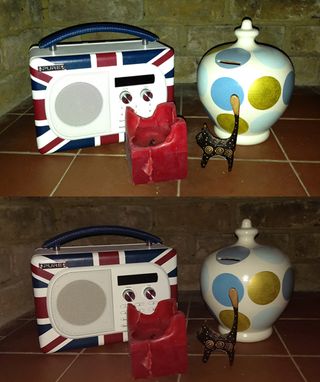
A small but still rather annoying niggle is that the camera always launches in landscape mode, so you have to turn the phone to landscape orientation before moving back to portrait to be sure that the built-in motion sensor knows what’s going on. Hopefully, this is something that can be changed with a software update in the future.
The main camera settings menu lets you select different shooting modes, including a night mode for even better low-light shots; HDR (high dynamic range) for lifting shadows in direct sunlight; smile detection; and a sweep-panorama mode. The HDR function also works on the 2.1MP front-facing camera, too – perfect for those selfies taken in the sunshine.
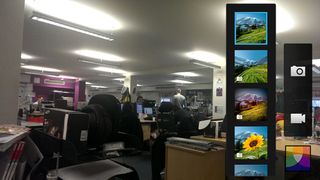
The HTC One can apply 15 real-time effects and filters to your photograph before you take it, and lets you choose from 12 different ones afterwards. Post-shoot editing also lets you add a choice of frame to your photo, and provides some retouching options and a crop tool.
Alongside its photo capabilities, the camera can capture full 1080p videos, and performs well. There are modes for 60fps shooting, HDR and slow-motion capture too, although it’s worth remembering that these mean a trade-off in quality.
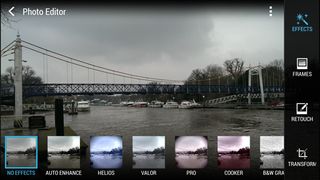
HTC One: Zoes
There’s also a completely new way of taking photos with the HTC One, called a Zoe (named after a zoetrope). It records a three-second video clip made from 20 individual stills that you can choose to save as a photo – though you will find a few are blurry if there’s lots of movement in your clip.
This lets you do two things. You can pick the best shot from a particular moment, of course, but you can also edit a photo to ensure everyone is looking their best – taking one person’s best shot from another picture in the Zoe and merging it with the one you want. In a similar vein, you are also able to remove unwanted objects from an otherwise perfect shot to get it looking just right.
MORE: Sony Xperia Z review
You can stitch up to ten Zoes together to create a 30-second movie overview of a certain event, too. The HTC One does this automatically by reading the metadata of your Zoes to establish the ones that were taken at the same time. You are then able to ‘remix’ it if you want to rearrange the order and change the way it looks.
How often any this will be used, we’re not sure – it certainly feels like a bit of a gimmick that will fall into the ‘never used features’ list after the first month or so. That said, it’s a nice touch to see the live gallery it produces, with the Zoe thumbnails autoplaying and coming to life as you scroll through them.
HTC One: Competitors
The HTC One is one of the first premium phones of 2013, meaning we’ll have to wait to see how it fares against its most obvious competitor, the Samsung Galaxy S4. However, against two of our current best-performing smartphones – the iPhone 5 and the Nexus 4 – it easily outspecs them on paper, and even gives them a run for their money in performance, too. The HTC One is looking a very promising prospect indeed.
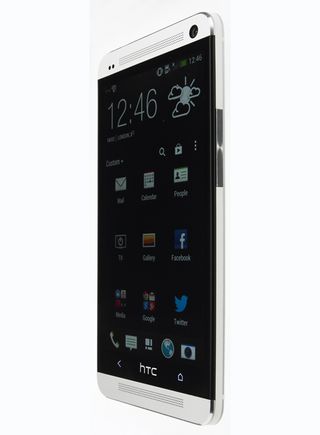
HTC One: Verdict
There’s a whole lot to say about the HTC One, and almost without exception, it’s all good.
The camera might not be as good as was promised, BlinkFeed won’t be for everyone and the Zoe photos could become a little used gimmick, but the overall package is an excellent one that’s pretty hard to find any serious fault in.
HTC has managed to create a well-designed, well thought-out phone both inside and out, which is sure to give its competition plenty of food for thought.
MORE: Best smartphones 2014
MORE: MWC 2014 news, rumours and what to expect
See all our Android smartphone reviews
What Hi-Fi?, founded in 1976, is the world's leading independent guide to buying and owning hi-fi and home entertainment products. Our comprehensive tests help you buy the very best for your money, with our advice sections giving you step-by-step information on how to get even more from your music and movies. Everything is tested by our dedicated team of in-house reviewers in our custom-built test rooms in London, Reading and Bath. Our coveted five-star rating and Awards are recognised all over the world as the ultimate seal of approval, so you can buy with absolute confidence.
